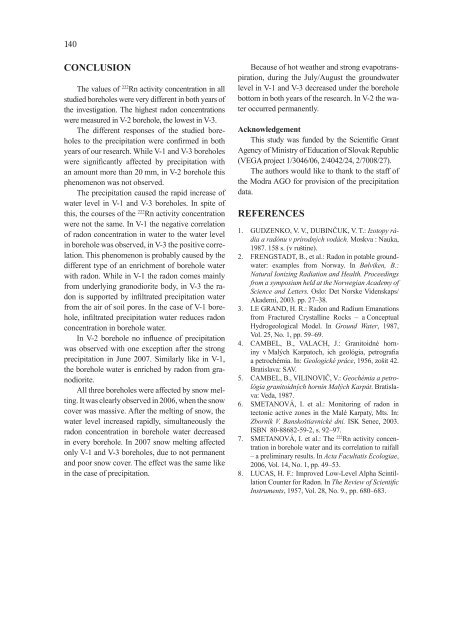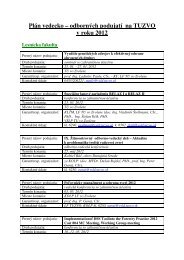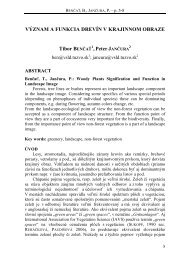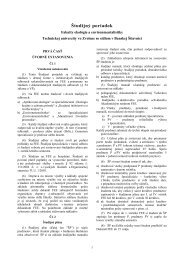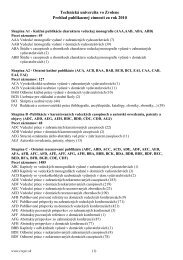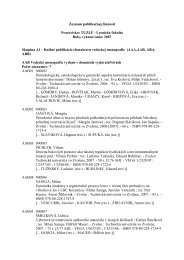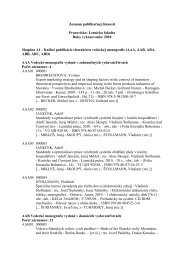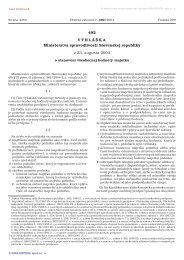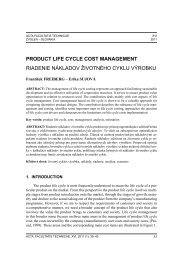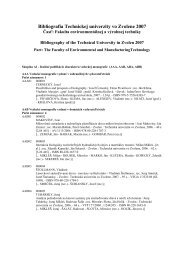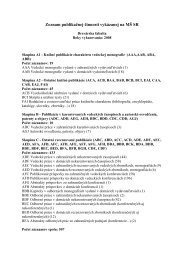Acta Facultatis Ecologiae - Technická univerzita vo Zvolene
Acta Facultatis Ecologiae - Technická univerzita vo Zvolene
Acta Facultatis Ecologiae - Technická univerzita vo Zvolene
- No tags were found...
You also want an ePaper? Increase the reach of your titles
YUMPU automatically turns print PDFs into web optimized ePapers that Google loves.
140CONCLUSIONThe values of 222 Rn activity concentration in allstudied boreholes were very different in both years ofthe investigation. The highest radon concentrationswere measured in V-2 borehole, the lowest in V-3.The different responses of the studied boreholesto the precipitation were confirmed in bothyears of our research. While V-1 and V-3 boreholeswere significantly affected by precipitation withan amount more than 20 mm, in V-2 borehole thisphenomenon was not observed.The precipitation caused the rapid increase ofwater level in V-1 and V-3 boreholes. In spite ofthis, the courses of the 222 Rn activity concentrationwere not the same. In V-1 the negative correlationof radon concentration in water to the water levelin borehole was observed, in V-3 the positive correlation.This phenomenon is probably caused by thedifferent type of an enrichment of borehole waterwith radon. While in V-1 the radon comes mainlyfrom underlying granodiorite body, in V-3 the radonis supported by infiltrated precipitation waterfrom the air of soil pores. In the case of V-1 borehole,infiltrated precipitation water reduces radonconcentration in borehole water.In V-2 borehole no influence of precipitationwas observed with one exception after the strongprecipitation in June 2007. Similarly like in V-1,the borehole water is enriched by radon from granodiorite.All three boreholes were affected by snow melting.It was clearly observed in 2006, when the snowcover was massive. After the melting of snow, thewater level increased rapidly, simultaneously theradon concentration in borehole water decreasedin every borehole. In 2007 snow melting affectedonly V-1 and V-3 boreholes, due to not permanentand poor snow cover. The effect was the same likein the case of precipitation.Because of hot weather and strong evapotranspiration,during the July/August the groundwaterlevel in V-1 and V-3 decreased under the boreholebottom in both years of the research. In V-2 the wateroccurred permanently.AcknowledgementThis study was funded by the Scientific GrantAgency of Ministry of Education of Slovak Republic(VEGA project 1/3046/06, 2/4042/24, 2/7008/27).The authors would like to thank to the staff ofthe Modra AGO for provision of the precipitationdata.REFERENCES1. GUDZENKO, V. V., DUBINČUK, V. T.: Izotopy rádiaa radónu v prírodných <strong>vo</strong>dách. Moskva : Nauka,1987. 158 s. (v ruštine).2. FRENGSTADT, B., et al.: Radon in potable groundwater:examples from Norway. In Bølviken, B.:Natural Ionizing Radiation and Health. Proceedingsfrom a symposium held at the Norwegian Academy ofScience and Letters. Oslo: Det Norske Videnskaps/Akademi, 2003. pp. 27–38.3. LE GRAND, H. R.: Radon and Radium Emanationsfrom Fractured Crystalline Rocks – a ConceptualHydrogeological Model. In Ground Water, 1987,Vol. 25, No. 1, pp. 59–69.4. CAMBEL, B., VALACH, J.: Granitoidné horninyv Malých Karpatoch, ich geológia, petrografiaa petrochémia. In: Geologické práce, 1956, zošit 42.Bratislava: SAV.5. CAMBEL, B., VILINOVIČ, V.: Geochémia a petrológiagranitoidných hornín Malých Karpát. Bratislava:Veda, 1987.6. SMETANOVÁ, I. et al.: Monitoring of radon intectonic active zones in the Malé Karpaty, Mts. In:Zborník V. Banskoštiavnické dni. ISK Senec, 2003.ISBN 80-88682-59-2, s. 92–97.7. SMETANOVÁ, I. et al.: The 222 Rn activity concentrationin borehole water and its correlation to raifall– a preliminary results. In <strong>Acta</strong> <strong>Facultatis</strong> <strong>Ecologiae</strong>,2006, Vol. 14, No. 1, pp. 49–53.8. LUCAS, H. F.: Improved Low-Level Alpha ScintillationCounter for Radon. In The Review of ScientificInstruments, 1957, Vol. 28, No. 9., pp. 680–683.


